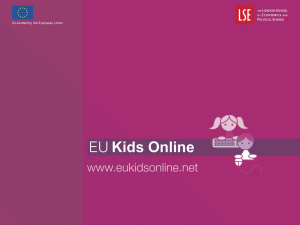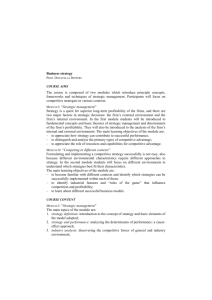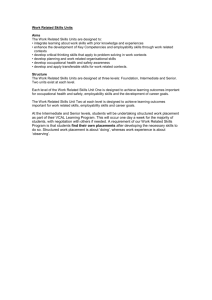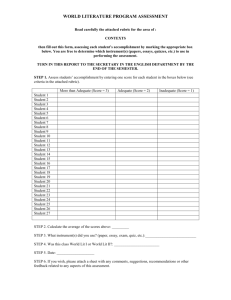Poster Presentation Tips
advertisement
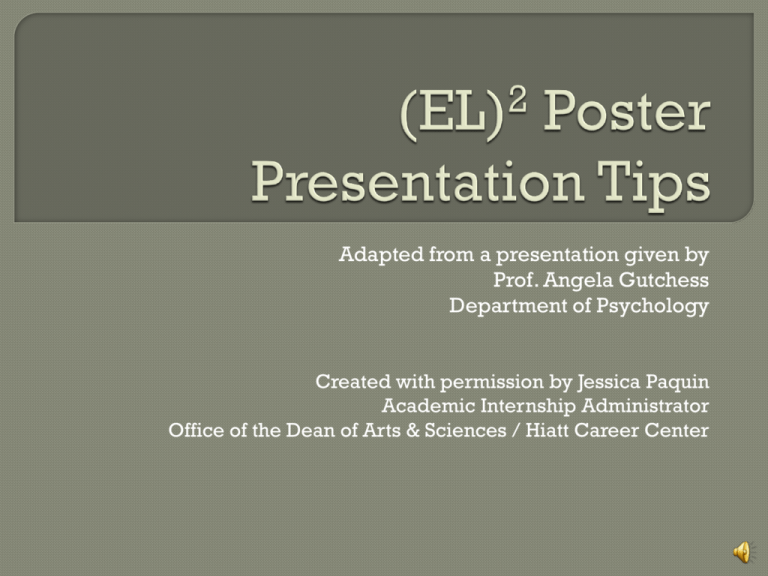
Adapted from a presentation given by Prof. Angela Gutchess Department of Psychology Created with permission by Jessica Paquin Academic Internship Administrator Office of the Dean of Arts & Sciences / Hiatt Career Center (EL)2 is a University-wide symposium highlighting the many ways undergraduates connect experience to their Liberal Arts education. This is a great opportunity for undergraduates to: Gain experience in presenting your work in a formal setting Receive feedback from faculty and peers Share ideas and learn from other students Enhance your resume When creating your poster, remember Experiential Learning is: An Intellectual Challenge Tackle real-world problems for which there are no answers in the back of the book. Challenge your powers of observation, analysis and creative thinking. Test theories against the concrete; experience, create and prove new theories. A Practical Experience Explore the world of a professional in the field. Ask yourself, "Is this field the right fit for me?" Sharpen applications for graduate school and employment by documenting skills and experience. Opportunity for Personal Growth Develop skills to work in groups or independently. Appreciate differences in learning style, values and world view. Practice taking informed risks, and learn from mistakes as well as successes. htwww.brandeis.edu/experientiallearning/for students/index.html Usually 1 foam board No tri-folds 40” x 30 or 32” White or black Project Title 32” • Name • Year • Contact Info 40 ” What did you do? • Why interesting? Important? But not ONLY about what you did • Outcomes? Who was affected? • Reflection? How were you affected? • Helpful information/advice to share with others? • Why would others want to know about this? Begin to make a mental outline • What journey do you want people to take? What were the biggest issues? …Unexpected results? …Proudest achievements? …Lessons learned? What are your next steps? Readable Legible Well-Organized Succinct Limited time to convey your message to your audience • May have <3 minutes/person • What are your most important points? Choose one memorable message Avoid grammar & punctuation mistakes Do the topics resonate with the audience? • Why should they know this? • The “grandmother” rule: Would she understand it? Studies show you only have 11 seconds to grab and retain the audience’s attention. Aim for “visually clean and pleasing” Can they read it from 6-10 feet away? A poster is not a cut-up essay • (Again)What are your most important points? • Large font!! (30+ point) • High contrast font colors • Borders or mounting sections of text help Spatial organization makes the difference between reaching 95% rather than 5% of the audience. Audience shouldn’t have to hunt for main idea/ takeaways Space A in-between sections; Visually neat good flow of logic Impactful, short titles • Avoid jargon • Borders or mounting sections of text help Don’t overwhelm them, entice them! • Think of 1-2 sentences to say to everyone • What are your most important points? Your one memorable message? Keywords and Section headings that make an impact Pictures and graphs instead of paragraphs Show, don’t tell • Less (text) is more • Bullet points Can you use organization’s handouts? Photos & figures speak volumes and break up sections Use of color (if you can) • Printing • Borders/mounting May differ depending on the type of poster (Science Research vs. others) Personalized Titles Challenges Methods Successes Outcomes Lessons Research Topic/ Highlights Problem Organization/Lab Learned of the Experience Next Steps… where is this taking you? Note the next slide… Too much information Too many details Too little space between sections Results aren’t obvious Contextual False Memories and Aging Angela Gutchess1, 2, Elissa Aminoff 2, 3, Moshe Bar2, & Daniel L. Schacter2, 3 1Brandeis University, 2Massachusetts General Hospital, 3Harvard University RESULTS Hits False Alarm s 0.70 0.70 Strong Weak 0.50 0.40 0.30 0.20 0.10 0.00 Strong 0.60 False Alarm rate 0.60 Hit rate Recent data (Aminoff, Schacter, & Bar, in press) illustrate that related contextual information can lead to false recognition in young adults. Items that occur in the same spatial contexts (e.g., stove and a dishwasher from a kitchen context) are prone to false recognition. Because contextual false memories rely on related information, older adults may be expected to exhibit elevated rates of false recognition. However, contextual information can support accurate memory and the benefits from it may be relatively intact with age (e.g., Chee et al., 2006; Gutchess et al., 2007). This study investigated the influence of age on false memories for contextual information. We replicated previous findings for young adults that strong contexts enhanced both hit and false alarm rates. While older adults showed a similar increase in hit rates for strong contexts, their false alarm rate was no higher for strong than weak contexts. This finding contrasts previous research showing an increase in false alarms with age to related information. Weak 0.50 0.40 0.30 Yo ung 0.10 Elderly Hits Young Elderly Strong_related Weak_old Weak_lures Condition Yo ung Elderly Group False Alarms Main effect of context, F(1, 54) = 74.45, p<.001 Main effect of context, F(1, 54) = 20.56, p<.001 No effect of age, F(1, 54) = .00, p>.95 No effect of age, F(1, 54) = 1.08, p>.30 No interaction, F(1, 54) = .51, p>.45 Age x ctx interaction, F(1, 54) = 3.93, p=.05 Experiment 2 The results of Experiment 1 suggest that young, but not older, adults are more prone to commit false alarms to strong contexts than weak contexts. Although this finding represents a potential exception to the tendency for older adults to have higher rates of false memories for related information, it is possible that older adults found the contexts less rich than younger adults, or did not generate contextually-related items during encoding to the same extent as young. Experiment 2 explored these possibilities. METHODS After a 24-hour retention interval, participants judged whether words corresponded to pictures they had studied on the previous day. In a self-paced design, participants decided whether or not they saw a corresponding picture in the first part of the study for 162 words, and made a “Remember”, “Know”, or “New” judgment. 84 of the words corresponded to studied strong contexts, with 42 targets and 42 lures. 78 words were weak context items, with 39 target and 39 lures. 0.80 0.70 0.60 0.50 0.40 0.30 0.20 0.10 0.00 Strong_old 0.20 Group METHODS Recognition accuracy 0.00 Experiment 1 28 young (M age = 23.7) and 28 older (M age = 71.4) adults viewed photos of individual objects on light gray backgrounds. Participants incidentally encoded 84 strong context picture pairs (see below) and 39 weak context picture pairs (e.g., camera & scissors) by rating the extent to which the picture pairs constituted a context (1=‘objects don’t fit a context’, 2=‘only the depicted objects fit a context’, 3=‘only a few more objects fit a context’, 4=‘many more objects fit a context’). Pictures were presented for 2000 msec, followed by a ratings scale for 2000 msec, and trials were interspersed with fixation trials. Main effect of context, F(1, 32) = 13.41, p<.002 Main effect of veridical studied item vs. related, F(1, 32) = 59.35, p<.001 Trend for an interaction of context x related/old, F(1, 32) = 2.88, p=.10 No trends for main effects of interactions involving age, Fs<1.5 Prop "yes" responses INTRODUCTION False recognition of related information occurs more frequently with age. For example, older adults are more likely to false alarm to new exemplars drawn from categories of previously studied pictures, such as a new picture of a cat after encoding pictures of other cats (Koutstaal & Schacter, 1997; Koutstaal, 2003). 17 young (M age = 23.2) and 17 older (M age = 74.6) adults participated in this experiment. With the exception of the nature of the memory test, the methods were identical to Experiment 1. Participants completed an inclusion test (adapted from Brainerd & Reyna, 1998; Schacter, Cendan, Dodson, & Clifford, 2001), making judgments of whether the words presented at recognition corresponded to, or were related to, a previously studied context. This modified recognition test allowed us to assess the extent to which young and older adults encoded the contexts and assessed the recognition items as related to them. Participants rated the relatedness of the critical target or lure item to the original context pair (e.g., stroller-bottle, crib) as an additional measure of the extent to which items were perceived as contextually-related. All three items were presented to participants so that this task made no memory demands. A rating of ‘1’ indicated “definitely yes (the item fits the same context as the pair)” and a rating of ‘4’ indicated “definitely no”. The average ratings for the triplets were: Young = 1.51 Elderly = 1.37 Across all items, elderly rated the items as significantly more related to the contexts than the young adults, t (334) = 3.29, p<.001. DISCUSSION In Experiment 1, we present evidence that strong related contextual information, compared to weak contextual information, leads young adults to commit memory errors disproportionately more than older adults. This finding contrasts a wealth of literature showing that older adults falsely recognize related information more than young adults (e.g., Koutstaal & Schacter, 1997; Koutstaal, 2003). Although for both young and elderly hit rates are similarly higher for strong contexts than weak, Experiment 2 addresses the extent to which contexts were considered differently across the age groups. On the basis of age-equivalent performance on an inclusive memory test and similar ratings of contextually-related triplets, we rule out the alternative explanation, that contexts were impoverished or less meaningful for older adults than young. Even under conditions in which young adults are prone to commit memory errors, older adults are no more prone to falsely endorse items strongly related to specific contexts than those weakly related to many contexts. We suggest that the rich, supportive information provided by contexts can facilitate memory with age, supporting accurate recognition without leading older adults to generate false memories. RESULTS bottle crib Results indicate that young and elderly do not differ in the extent to which they consider items to be related to previously studied contexts. This suggests that the results of Experiment 1 do not reflect age differences in ideas about what consistutes a context, or the ability to generate items related to a context. REFERENCES Aminoff, E., Schacter, D. L., & Bar, M. (in press). The cortical underpinnings of context-based memory distortion. Journal of Cognitive Neuroscience. Brainerd, C. J. & Reyna, V. F. (1998). When things that were never experienced are easier to “remember” than things that were. Psychological Science, 9, 484-489. Chee, M. W. L., Goh, J. O. S., Venkatraman, V., Tan , J. C., Gutchess, A., Sutton, B., Hebrank, A., Leshikar, E., & Park, D. (2006). Age-related changes in object processing and contextual binding revealed using fMR-Adaptation. Journal of Cognitive Neuroscience, 18, 495-507. Gutchess, A.H., Hebrank, A., Sutton, B., Leshikar, E., Chee, M.W.L., Tan, J.C., Goh, J.O.S., & Park, D.C. (2007). Contextual interference in ACKNOWLEDGEMENTS: We gratefully acknowledge Kelly Fitzgerald, Sarah Stein, and Allie Indeck for assistance with data collection and analysis. CONTACT: gutchess@brandeis.edu recognition memory with age. Neuroimage, 35, 1338-1347. Koutstaal, W. (2003). Older adults encode--but do not always use--perceptual details: intentional versus unintentional effects of detail on memory judgments. Psychological Science, 14, 189-193. Koutstaal, W., & Schacter, D. L. (1997). Gist-based false recognition of pictures in older and younger adults. Journal of Memory and Language, 37, 555-583. Schacter, D. L., Cendan, D. L., Dodson, C. S., & Clifford, E. R. (2001). Retrieval conditions and false recognition: Testing the distinctiveness heuristic. Psychonomic Bulletin & Review, 8, 827-833. Better... Much more space between ideas Sections are clear Discussion reduced and readable Graphics steal the show Want to spend time getting gist Don’t overwhelm them, entice them! Aging Affects Memory for Valenced Character Information Megan J. Limbert & Angela H. Gutchess Brandeis University METHODS (cont’d.) INTRODUCTION -Age differences in memory performance disappear when the content is socioemotional or personally meaningful (Rahhal et al., 2002; May et al., 2005) - According to Socioemotional Selectivity Theory, emotional, specifically positive, information, is prioritized with age (Carstensen, Isaacowitz, & Charles, 1999), but it may be that the advantage of emotion holds only for remembering general ideas as opposed to specific details -There is evidence that the way in which older and younger adults differ in memory performance based on the positivity or negativity of images changes as a function of whether that memory is for general or specific information (Kensinger, Garoff-Eaton, & Schacter, 2007) -We sought to compare how young and older adults remember both general and specific information when that information is socioemotionally relevant or neutral Specific Memory -Each pairing presented for 5 sec. during encoding; participants were asked to form an impression of each individual -Performance in this domain judged according to two sets of criteria, “strict” and “lenient” -During recognition & recall phase, each face & name presented again; participants were asked: - “What kind of impression did you form of this person?” (forced choice of good, bad, or neutral, which assessed memory for the character/impression of the individuals - general memory ) -”What else do you remember about this person?” (assessed memory for the associated behavior/characteristic - specific memory) -Only when judged by “strict” criteria, is there a main effect of valence (F(2,76) = 9.667, p < .001, ηp2 = .203), with neutral information remembered better RESULTS Response Bias -But younger adults remember more detailed information overall than older adults, (F(1,38) = 65.070, p < .001, ηp2 = .631 (strict) F(1, 38) = 44.020, p < .001, ηp2 = .537 (lenient)) -Trend for an interaction only with “lenient” criteria (F(2, 76) = 2.525, p = .087, ηp2 = .062 ), with older adults appearing to benefit from valenced information relative to neutral -Evidence for systematic bias in the way participants guessed: older adults incorrectly used “positive” label more than younger adults (t(38) = -3.610, p = .001) Average Performance (+SE) on Specific Memory Task by Valence, Scoring Criteria, & Age -Applied a guessing correction based on the adaptation of Cohen’s (1960) kappa statistic, as devised by Isaacowitz et al. (2007) METHODS Corrected General Memory - 48 faces paired pseudo-randomly with 48 names and sentences designed to color the individual in a negative, positive, or neutral light -Young participants outperform older (F(1, 38) = 6.990, p = .012, -Faces rated similarly on memorability, familiarity, & mood (Kennedy, Hope, & Raz, in press) -Memory for positive and negative better than memory for neutral stimuli for both age groups (F(1, 19) = 27.107, p <.001) & (F(1,19) = 18.485, p <.001) -Positive and negative sentences no different on ratings of arousal (t = 1.846, p > .05 [two-tail]) or valence (t = .709, p > .05 [two-tail]) for positive and negative groups. -Memory for positive information equal to that for negative for both age groups (F(1, 19) = 3.484, p = .077) & (F(1, 19) = 1.923, p = .182) ηp2 = Kappa-Corrected General Memory Score Averages (+SE) by Age William This person donates blood regularly. Rachel This person embezzles money. Kappa-Corrected Performance 0.8 .155) Proportion Correctly Recalled 0.8 - 20 young (M age = 18.95) and 20 older (M age = 75.15) adult participants 0.7 0.6 0.5 0.4 Young 0.3 Old 0.2 0.1 0 Pos. (S) Neu. (S) Neg. (S) Pos. (L) Neu. (L) Neg. (L) Valence & Scoring Criteria DISCUSSION -In remembering general impressions, younger adults outperform older adults, no matter the valence of the information 0.7 0.6 Young Old 0.5 0.4 0.3 0.2 0.1 0 Pos. Neu. Valence Neg. -Socioemotional information is better remembered than neutral no matter the age group, replicating previous experiments (e.g. Hamann et al., 1999; Doerksen & Shimamura, 2001) and extending this advantage to older adults, but only when those memories are of the general idea, as opposed to specifics, of the original information -There is no evidence for positivity effects for general or specific memory, except in that older adults have a guessing bias towards positivity ACKNOWLEDGEMENTS: We gratefully acknowledge Derek Isaacowitz, Corinna Löckenhoff, Matt King, and Xiaodong Liu for helpful comments and statistical advice, and Phyllis Blumberg, Abraham Lipton, Shirley Lo, Lila Starbuck, Jennifer Silverberg, and Becky Sokal for assistance with data collection, scoring, and organization. CONTACT: gutchess@brandeis.edu Proofread!! Get feedback from friends or mentors before printing • Clear & easy to understand? • Clean & well designed? • Memorable message? Know what you most want to tell people • 1-2 sentence version; 3 minute version Last year’s official program Students present their posters during the poster session. • Clear sections • Colorful borders • Clean and easy to read • Not too overwhelming • Interesting graphics • “Grabbing” Keywords The Effect of Denervation and Reinnervation of Sympathetic Neurons on Myocytes Nithya Setty, ‘09, BIO • Simple design • Colorful/ use of contrasting colors • Basic but important Sections (What We Learned) • Supporting graphics ‘Deis Bikes: Brandeis Bicycle Rental Program Caroline Cappello, ‘11, THA, Chenchao Lu ‘09, BIO & ECON, Lea Giddens, ’11, IGS, Lisa Frank ‘09, POL, Paul Balik ‘10 POL, Susan Paykin, ‘11, IGS • Newspaper article • Artistic borders • Personalized title • Quotations • Colorful • Impactful sections: -Personal Reflection -Goals -Outcomes Living the Conflict: Bringing Positive Change to Arab- Israeli Relations in Israel Marnina Cowan, ’10, IGS & HBRW • Professionally printed • Graphics with title • Catching title • Clear sections and results • Good use of photos & graph • Clear & easy to read • Sections are bordered Life in the Emotional Lab: Two Student Perspectives Dawn Schwartz ’09, PSYC & Jonah Cohen ’10, PSYC • Border around poster = contrasting color • Bordered sections • Bullets instead of sentences • Creative section titles: -In Hindsight -Samples Internship with the Museum of Fine Arts, Boston Allison Young, ’09, FA & ANTH What will your symposium poster look like? March 18th, 2010 Apply now! Rolling applications; notifications in October & February Questions? experientiallearning@brandeis.edu You’re experienced, but are you engaged?



